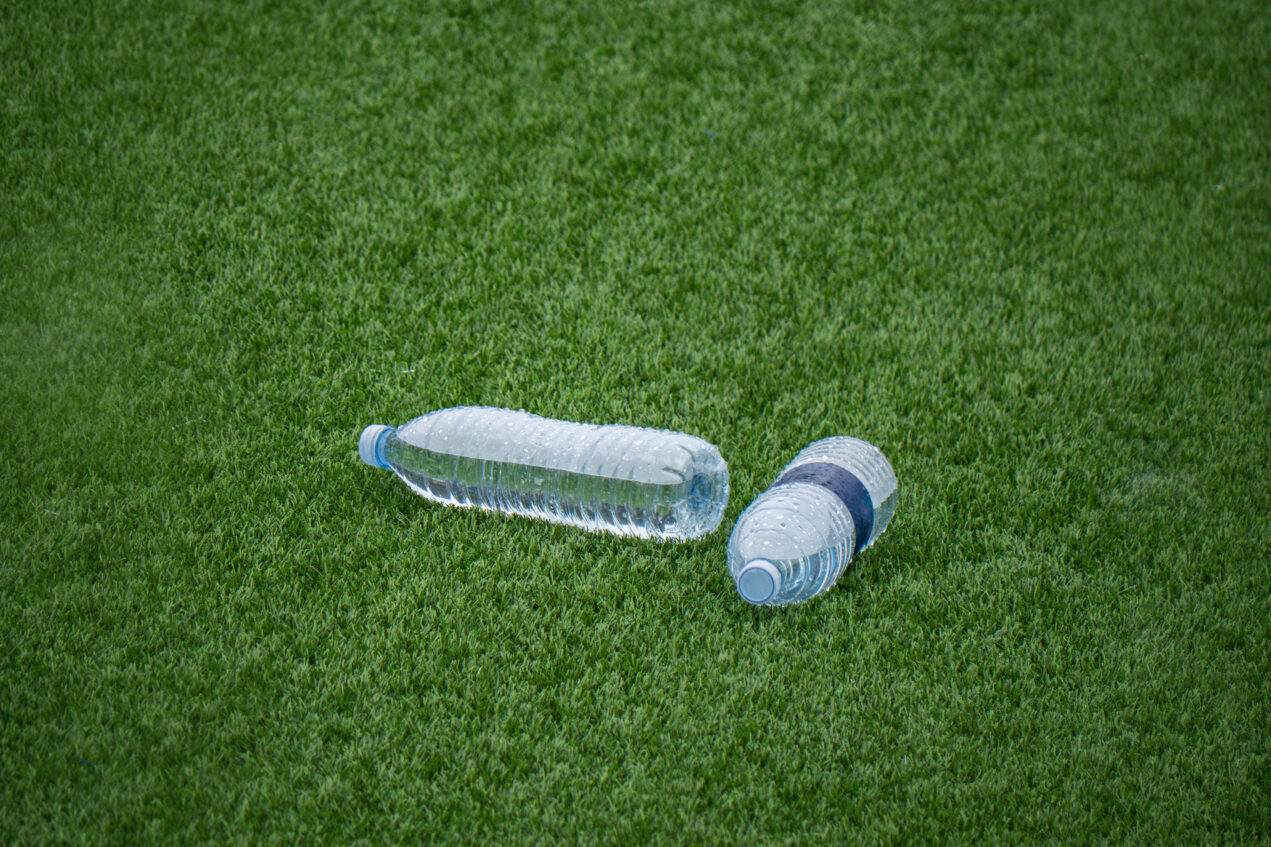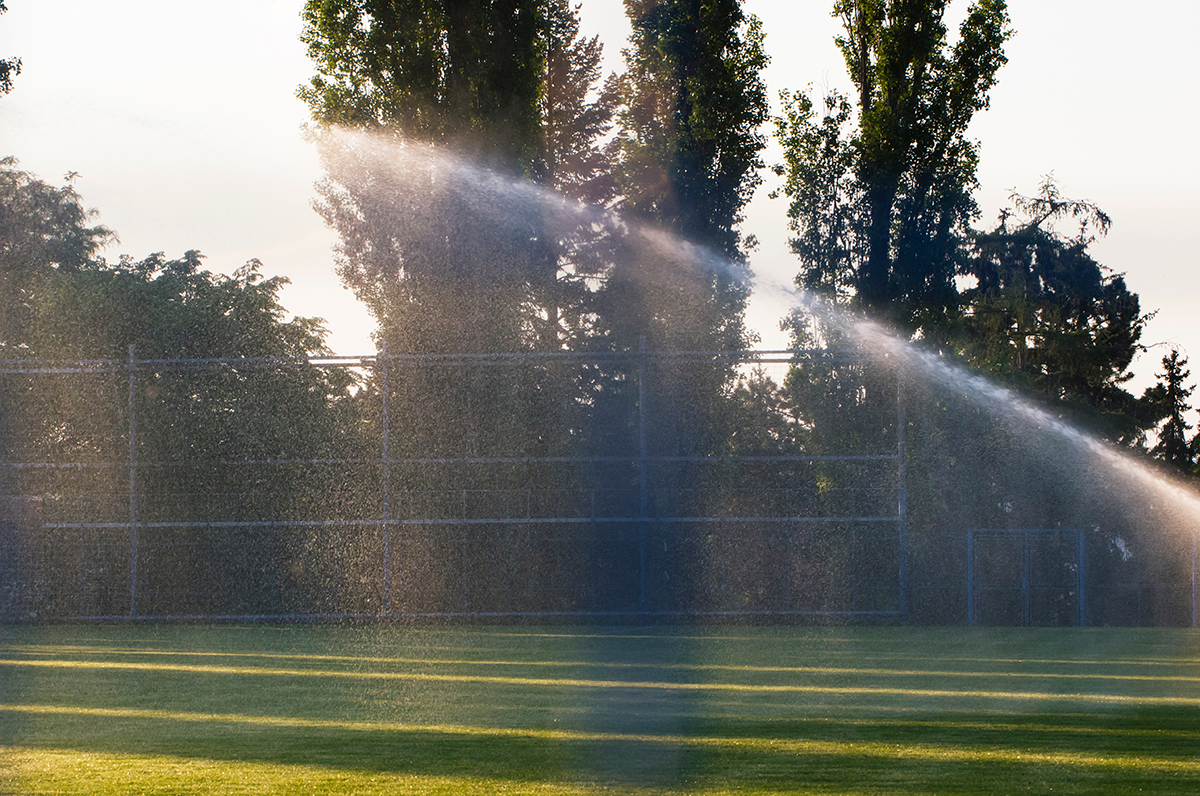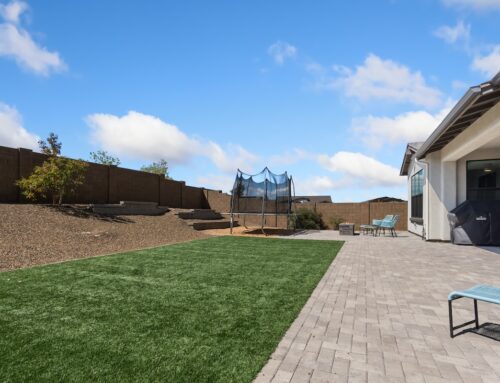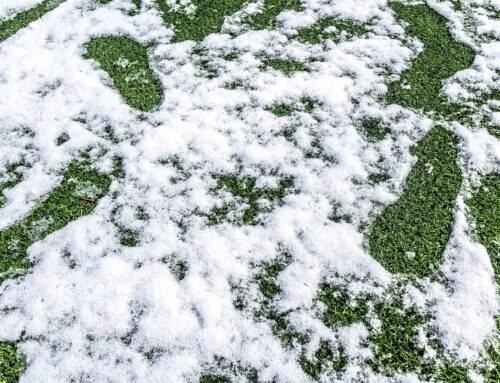Last Updated on August 4, 2023 by ReTurf
Artificial turf is a game-changer, folks.
Imagine having a lush green lawn all year round without the constant mowing and watering. Sounds like a dream, right?
The reality of sustainable artificial turf is indeed quite appealing. But it’s not always a picture-perfect scenario.
When summer rolls around, your perfect lawn might feel more like hot coals underfoot. And that’s where understanding how to manage heat on your artificial turf comes into play.
Understanding the Problem with Artificial Turf in Summer
When it comes to artificial turf, a common concern arises during those hot summer months. It involves the synthetic materials used in creating these turfs and their tendency to heat up.
The Science Behind Hot Artificial Turf
Synthetic or artificial grass is designed to mimic natural grass fields. The dark green color contributes significantly towards this goal but also leads to more absorption of sunlight than reflection. This causes an increase in temperature on your synthetic lawn, making it hotter than its surrounding environment.
Temperatures on an artificial lawn can be as much as 60 degrees higher compared to natural grass under similar conditions.

Impacts of High Temperatures on Artificial Turf
This overheating issue isn’t just about discomfort for users stepping onto hot turf barefooted or pets walking across them; high temperatures also have implications for your synthetic lawns’ longevity. Consistent exposure over time without proper maintenance measures could lead your turf to show signs of wear and tear sooner than expected.
Prolonged exposure may result in fading colors due to UV damage and even melting fibers if temperatures get excessively high – both detrimental effects impacting aesthetics and overall functionality. Long-term exposure at elevated temperatures could reduce tensile strength – a fundamental property ensuring durability against constant foot traffic – by almost half.
Embracing Sustainability with ReTurf’s Recycled Turf
What is ReTurf?
ReTurf stands out from other companies providing new and used synthetic playing surfaces because we’re all about top-quality used artificial turf. We source old athletic fields that are past their prime, but still have plenty of life left within them; we then repurpose those into new lawns ready to install for residential, commercial, sports, or DIY/hobby uses.
ReTurf’s mission? To extend the useful lifespan of turf beyond the initial installation site, thereby reducing landfill waste and carbon footprint.
Benefits of Using Re-Using Turfs from ReTurf
Apart from contributing positively towards the environment through recycling practices…
Our unique processing techniques ensure each product undergoes rigorous quality checks before hitting market shelves – guaranteeing durability alongside superior performance under harsh weather conditions, including intense summer heat. Stay tuned for more information coming soon…
.
The Gist:
Artificial turf can get scorching hot in summer due to its synthetic materials absorbing sunlight, potentially causing discomfort and damaging the turf over time. Opt for sustainable solutions like ReTurf’s recycled turfs, which reduce environmental impact and provide durability and superior performance.
Embracing Sustainability with ReTurf’s Recycled Turf
In the artificial turf industry, sustainability is becoming a key consideration. One company that stands out in this regard is ReTurf, which specializes in providing recycled synthetic grass.
This commitment not only diverts waste from landfills but also reduces the demand for new materials required to manufacture fresh turf. Choosing ReTurf means making an environmentally responsible choice without compromising quality or aesthetics.
What is ReTurf?
The concept behind ReTurf revolves around repurposing used artificial turf instead of discarding them in landfill sites. This innovative approach aligns perfectly with modern-day sustainability goals and offers numerous benefits beyond ecological considerations.
- Saving costs – Recycling turfs makes these products significantly more affordable than their brand-new counterparts.
- Aesthetic appeal – Just because it’s reused does not mean it looks second-hand. We take great care to ensure each roll retains vibrant green coloration and mimics natural grass as closely as possible, thus creating visually pleasing outdoor spaces everyone can enjoy.
Benefits of using recycled turfs from ReTurf
Take into account that the result may differ depending on personal conditions, like geographical area and sun exposure, among other variables to take into consideration when selecting what product best suits your requirements.
In conclusion, embracing sustainability through choices like Recycled Turf contributes positively to the environment, your wallet, and overall ownership satisfaction. Therefore, it is worth considering investing in Recycled Turf for its potential benefits.
The Gist:
Choosing ReTurf’s recycled synthetic grass is a win-win. Not only does it save costs, but it also helps divert waste from landfills without compromising aesthetics. So make an eco-friendly choice that benefits your wallet and the planet.
Expert Tips to Keep Your Artificial Turf Cool During Summer
The scorching summer heat can be a formidable adversary for your artificial turf. However, armed with the proper knowledge and techniques, you can ensure that your lawn remains cool and comfortable throughout these hot months.
Let’s explore some expert-approved strategies to help manage the temperature of your synthetic grass effectively during summer.
Master Proper Watering Techniques
You might be wondering, why water an artificial lawn? After all, unlike natural grass fields that require regular hydration to stay lush and green, synthetic turf doesn’t need moisture for growth. However, watering your artificial turf serves a crucial purpose – it helps lower the surface temperature of your synthetic turf, making it more comfortable during hot summer days.
But there’s a science behind effectively cooling your artificial lawns without wasting precious water resources. It’s not as simple as just hosing down randomly; you’ll want to follow specific techniques to ensure maximum cooling effects while promoting sustainability.
Water Deeply But Less Frequently
Rather than shallow watering at frequent intervals (which can lead to quick evaporation and minimal cooling), consider deeply watering your artificial grass less frequently. This approach allows moisture penetration into deeper layers of the crumb rubber pellets used in many artificial turfs. These moistened layers then gradually release back up over time, keeping surfaces cooler over extended periods.
Avoid Peak Sun Hours
To further conserve water while maintaining optimal playing surfaces on high school sports grounds or even residential yards with synthetic turf installations, avoid peak sun hours when evaporation rates are highest. Instead, opt for early morning or late evening irrigation schedules that work best.
If you’re installing turf using ReTurf’s DIY resources, these tips will help keep maintenance easy and effective this summer. Remember: although “artificial grass isn’t green forever,” proper care can extend its lifespan significantly!
Harness The Power Of Shade
As we enter the summer months, it’s essential to understand how sunlight exposure can affect your artificial turf. When exposed to direct sunlight, synthetic turf fibers absorb heat, leaving the turf hotter underfoot – especially during peak mid-day hours. In hot climates, this is an inherent characteristic of all grass playing surfaces, including natural grass fields and fake grass.
The solution? Harnessing the power of shade! By blocking out excessive sunlight from reaching our lawns, we can significantly reduce heat absorption and keep our green lawns comfortable even on hot days.
Pergolas & Sail Shades: Your Allies Against Sunlight
If installing artificial turf in your backyard or revamping existing ones with ReTurf products, consider incorporating permanent installations like pergolas into your design plans. These structures provide much-needed shade and add an aesthetic appeal to your outdoor space.
For those who prefer more flexibility or have budget constraints while installing artificial grass, temporary solutions such as sail shades are a great alternative. They offer adequate sun protection for your lawns without requiring substantial investment or commitment.
The Natural Shield: Planting Trees Strategically
Beyond built structures, planting trees strategically around yards offers dual benefits – they serve as natural shields against harsh sunlight and enhance overall aesthetics, making them ideal companions when installing turf at home. This strategy aligns perfectly with ReTurf’s mission towards sustainability by reusing quality artificial turfs, thereby eliminating ornamental lawns that consume potable water excessively, unlike their synthetic counterparts, which are essentially impermeable.
In addition to providing DIY resources for maintaining these beautiful green spaces throughout summer (and beyond), ReTurf encourages responsible landscaping practices that promote environmental conservation while ensuring high-quality results for all sports fields, whether high school sports grounds or professional stadiums!
Use Cooling Infills Effectively
Cooling infills represent one key element within broader solutions to managing excessive heating issues associated with installing artificial turf.
Different varieties offer unique advantages based on specific needs, requirements, etc. For instance, some infills will actually absorbs stores, and release moisture similar to the human body’s sweat mechanism, helping to considerably lower temperatures.
The Gist:
Beat the summer heat with your artificial turf by mastering deep, infrequent watering techniques, utilizing shade structures or strategically planted trees to block direct sunlight, and using cooling infills effectively. Remember: a cool lawn equals comfortable feet.
DIY Techniques for Keeping Your Turf Cool
In artificial turf maintenance, many DIY methods have emerged that can help you keep your synthetic grass cool. These techniques involve using everyday household items or simple tools available at home, and they’re not only cost-effective but also offer an engaging hands-on experience.
Creating Homemade Sprinkler Systems
A strategy worth exploring entails creating homemade sprinkler systems explicitly designed for cooling down hot spots on synthetic playing surfaces through evaporation cooling – a similar principle used in evaporative air conditioners.
This may sound complicated initially; however, it’s simpler than you think. All that is required are some basic supplies such as PVC pipes, connectors, along with a garden hose.
Create a frame over the area most needed, and attach spray nozzles facing downwards towards the fake grass. Connect one end of the setup, and voila – an efficient watering system capable of irrigating and lowering the temperature within minutes.
Cooling Through Shade Creation
Finally, among our DIY tips, shade creation works wonders in dealing with high temperatures on natural grass fields, especially during peak summer days. Whether permanent structures like pergolas or temporary solutions like portable gazebos or pop-up tents, anything that helps reduce exposure to intense sunshine ultimately lowers overall temperature levels across the entire yard area, making it more comfortable and enjoyable for everyone involved.
The Gist:
Beat the summer heat with DIY techniques for your artificial turf. Try homemade sprinkler systems to cool hot spots through evaporation cooling. And don’t forget shade creation – a simple yet effective way to lower temperatures and make your yard more enjoyable.
Long-term Advantages of Maintaining Cooler Artificial Turf
The benefits of a cooler artificial lawn extend beyond immediate comfort. Proper temperature management can increase the lifespan and enhance the aesthetic appeal over time.
Extending the Life Span of Your Artificial Lawn Through Optimal Temperatures
A well-kept artificial lawn isn’t just about its looks; it also depends on how long it lasts. The durability and functionality depend significantly on how effectively you manage its temperatures. Excessive heat exposure could lead to premature wear-and-tear or discoloration in your synthetic grass.
In essence, you’re investing in extending years more use from your fake grass by keeping temperatures down with techniques such as using cooling infills or watering correctly (as discussed earlier).
Preserving Aesthetics by Preventing Heat Damage
Beyond practicality, homeowners often opt for synthetic lawns because they remain lush green year-round regardless of weather conditions – something natural grass fields cannot guarantee. However, without appropriate temperature control measures during hotter periods, color fading might occur due to excessive UV exposure, while melting points reached under intense sunlight could deform individual blades, making them look unnatural and worn out quicker than expected.
FAQs about Artificial Turf
What are the arguments against artificial turf?
Critics argue that artificial turf can heat up, making it uncomfortable in summer. They also cite environmental concerns due to its plastic composition and potential water runoff issues.
Is artificial turf bad for the environment?
Traditional synthetic turfs may pose environmental challenges due to their non-biodegradable nature. However, innovations like ReTurf’s repurposed products offer a more sustainable alternative.
What is the importance of artificial turf?
Artificial turf provides a low-maintenance, durable option for landscaping. It remains green year-round and eliminates watering needs, saving time and resources.
What are the pros and cons of artificial grass?
The benefits include lower maintenance costs, durability, and all-year-round appeal. Drawbacks involve initial installation costs, potential heat buildup during summer months, and some environmental concerns related to traditional synthetics.

Conclusion
Artificial turf and summer heat can be a challenging mix. Armed with this knowledge, you are now ready to take on the issue of artificial turf and summer heat.
The science behind hot artificial turf isn’t as daunting as it seems. You’ve learned how high temperatures impact your lawn’s longevity and usability.
You’ve discovered ReTurf – your sustainable solution offering recycled turfs perfect for beating the summer heat.
We shared expert tips on keeping your turf cool, from proper watering techniques to cooling infills and creating shade. And we didn’t forget about DIY enthusiasts, either!
Homemade sprinkler systems? They’re not out of reach anymore!
Beyond immediate comfort, remember there are long-term benefits too: extended lifespan of your lawn and preserved aesthetics through optimal temperature management.
If you’re ready to embrace a greener approach while ensuring maximum comfort during those scorching summers, consider exploring more about ReTurf. Let us guide you in selecting the best product for your needs, provide design assistance if needed, and share after-installation care recommendations explicitly tailored for artificial turfs. We promise – it’ll change your relationship with artificial grass forever!






